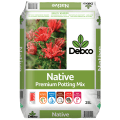When we think of our favourite herbs, we rarely think about our very own Australian Natives.
Indigenous Australians have cultivated bush tucker over thousands of years and have harnessed their countless health and culinary benefits.
Edible Australian native plants are unique to our growing conditions and, because of such, they boast unique and versatile flavours that can easily be grown in the Australian climate and incorporated into your modern cooking and medicinal remedies.
We’ve put together a list of our favourite Aussie native herbs to grow in pots, the veggie patch or the garden:
Native River Mint (Mentha australis)
Mentha australis is a low-growing herb that thrives on the riverbank and in other damp, boggy and/or shaded areas - hence why it is affectionately known as Native River Mint.
How to grow
Native River Mint needs regular watering and a potting mix for native plants to grow its best. Be sure to plant it in a pot or container garden to restrict it from spreading too far. Regular pruning will encourage bushier growth as it can grow quite leggy.
How to use
Boasting mint-scented and edible foliage, you can use Native River Mint fresh or dried in teas, juices and desserts or, enjoy it in more savoury dishes, like salads, sauces and dressings.
Native Thyme (Prostanthera incisa)
Also known as Cut-leaf Mint Bush, Native Thyme has mint-scented foliage that bursts with small purple flowers in Spring. Because of its shrubby nature, Native Thyme is suitable as a hedging or screening plant in your garden or as a feature plant in your garden beds!
How to grow
Preferring warmth and moisture, grow Native Thyme at home in a spot with full sun or part-shade and water generously in Summer.
Native Thyme is quite susceptible to root rot, so ensure that you use a potting mix with good drainage and that is slightly acidic and low in phosphorus, like Scotts Osmocote Potting Mix for Natives, to keep it happy and healthy.
How to use
Unlike regular mint or thyme, Native Thyme has a more complex flavour with earthy undertones and hints of pepper. This unique flavour makes it a great addition to use fresh or dried in a variety of dishes.
In particular, use Native Thyme to flavour fish, chicken, lamb and Australian game meat, such as kangaroo and emu. Additionally, the leaves and flowers can be used to make a delicious, minty herbal tea when steeped in hot water.
Lemon Myrtle (Backhousia citriodora)
As one of the most popular Australian native herbs, Lemon Myrtle is a beautiful tree with strong lemon scented foliage and clusters of white flowers. With a large range of medicinal and culinary benefits, Indigenous Australians have been using Lemon Myrtle for thousands of years.
How to grow
As a rainforest species originating in the subtropics of Queensland, it enjoys a warm spot in your garden with full sun to part-shade that is also protected from frosts and cold winds.
Alternatively, Lemon Myrtle grows well in pots and makes a great indoor plant, so you can enjoy its aesthetic value and fragrance inside the home! Ensure that you use a well-draining mix when planting or potting your Lemon Myrtle and keep it well watered.
How to use
Lemon Myrtle is naturally high in antioxidants, Vitamins A and E, calcium, zinc and much more! Hence, it is proven to be an effective cleaning agent and medicinal remedy, especially for cuts and colds. In cooking, use the tangy leaves and oil in teas, syrups and sauces, baked goods as well as to flavour meat dishes.
TIP: Harvest when the leaves are fully mature, so that their leaf structures, flavour and aroma profiles are well developed!
Cinnamon Myrtle (Backhousia myrtifolia)
Cinnamon Myrtle is an Aussie native with cinnamon fragrant leaves and fluffy, white flowers that bloom in mass from late-Winter through to Summer. For the best flavour, pick the soft young leaves!
How to grow
Cinnamon Myrtle is a frost-hardy and drought-tolerant plant that will grow its best in well-draining, moist soil with full sun to partial-shade.
Like Lemon Myrtle, you can also grow Cinnamon Myrtle in a pot and enjoy it as an indoor plant or as a feature plant to decorate your balcony or veranda.
How to use
Cinnamon Myrtle can be used in recipes where traditional cinnamon is called for like in stews and curries, sauces, baked goods and desserts, or infused in hot water to make an enjoyable and calming herbal tea. You can also mix Cinnamon Myrtle with Lemon Myrtle and fresh chilli to sprinkle over your lamb and veggies before roasting!
Aniseed Myrtle (Syzygium anisatum)
Also referred to as Ringwood, Aniseed Myrtle is renowned for its glossy foliage that boasts an aniseed and fresh eucalyptus flavour. In Spring and Summer, the tree bursts into clusters of white, scented flowers – making it a stunning feature and/or hedging plant for your garden.
How to grow
Aniseed Myrtle grows naturally in sub-tropical climates and prefers plenty of sun, consistent watering and a specialised mix, like Scotts Osmocote Potting Mix for Natives. They also respond well to being fed twice a year with a low-phosphorus fertiliser, such as Scotts Osmocote Controlled-Release Fertiliser for Natives.
How to use
Aniseed Myrtle leaves have a distinct aniseed and liquorice flavour, and the leaves can be used fresh or dried to flavour pasta, bread, sauces, meat dishes, plus more!
To dry out the leaves (which most recipes call for), use a food dehydrator or turn on the oven on a low temperature and dry out the leaves. Or, if you’re more patient, you can just leave them in a warm, dry place. Once dried, use a coffee grinder, or something similar, to grind them into a fine powder.
To make an Aniseed Myrtle herbal tea, simply infuse freshly picked leaves in hot water.













